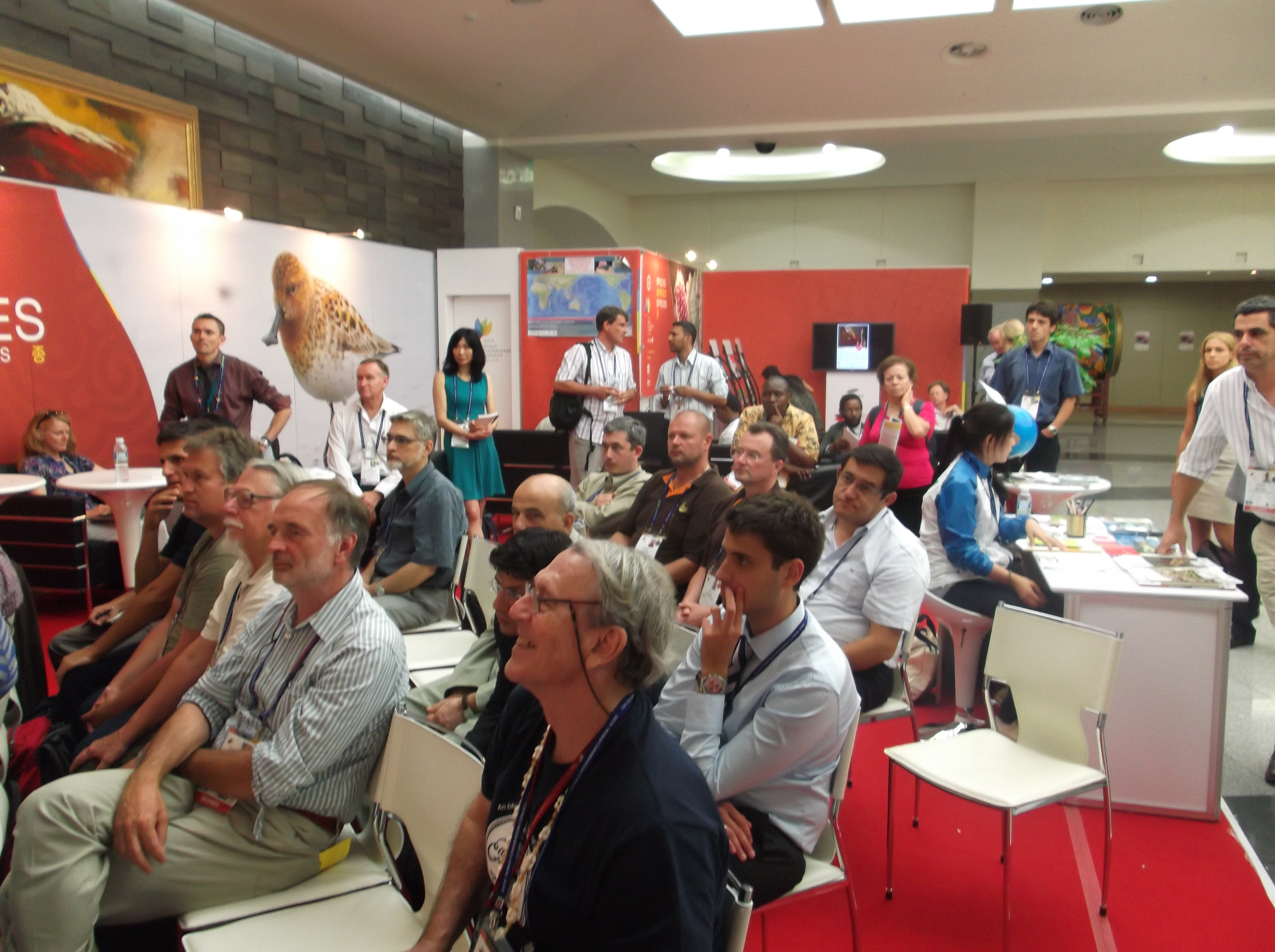This afternoon, I chaired a session in the Species Pavilion about the conservation status of species in Europe. My introductory words were based on the many European Red Lists that we have prepared for the European Commission over the past years, and I thanked Ana Nieto, who coordinates this work from our Brussels Office. Did you know that we have assessed more than 6000 species in Europe?
The following text is a short description of what the other speakers told us, with some of my personal observations included. The event was well attended, as you can see from the following photo
We had asked Eladio Fernandez-Galiano from the Council of Europe to reflect on the effectiveness of species conservation work in Europe. Eladio explained that Red Lists are used to develop European policy, that they are used to check compliance with conservation regulations, that they provide a focus for the preparation of conservation action plans, and that they for the basis for designation of conservation areas. He made the point that if we use protected area coverage in Europa as the indicator for success, we are doing well. However, the status of species and habitats is still deteriorating, so we need to do more to reverse these trends.
Eladio explained that one of the key drivers for deterioration of nature is the introduction of Invasive Alien Species, and he mentioned that a new strategy for IAS is being prepared by the European Commission. My reflection is that IUCN, through our Species Survival Commission Invasive Species Specialist Group, has helped with the preparation of this new strategy, and our IUCN Office in Brussels is organising an event in the European Parliament about IAS later this year. We are ready to offer our advice and help to the Commission in the implementation, monitoring and follow-up of this strategy and related regulations. During an evening reception later in the day, I talked with the European Association of Zoos and Aquaria – EAZA about their work on IAS in European zoos. I see opportunities for synergy and cooperation.
A slightly jetlagged Gregoire Dubois from the European Commission Joint Research Centre explained what the European Red List programme means for the Commission. He explained that the Life programme has spent more than 2billion Euro on several thousand of conservation projects between 1992 and 2006, and that a similar amount will have been spent between 2006 and 2013. He told us that in some cases Red List species conservation was a criteria for project approval, and therefore the Red Lists are critical for the European Commission.
The Commission has used the Red List in the establishment of a baseline for 2020, and they have made a commitment to halt the loss of species by 2020. Monitoring of trends is therefore important, and Gregoire stressed the need for repeat assessments. I realise that this is something we have already discussed with DG Environment in the European Commission, and we hope to agree on a series of repeat assessments in the years to come.
Simon Stuart, the Chair of the IUCN Species Survival Commission (SSC) reflected on the resources needed to maintain the capacity to develop additional Red Lists in Europe. Most of the work is done by individual experts in SSC, coordinated by the Secretariat. Simon explained that the SSC is currently not organised in a geographical manner, but that specialist groups are focused on taxa and species groups. He therefore wondered if we can be more strategic in Europe, if we create a European SSC sub-group.
Simon reflected on the fact that previous speakers confirmed that Red Lists are important for both the European Commission and the Council of Europe. I agree that this observation is critical as influencing biodiversity policies one of the key areas of focus for what IUCN in Europe is trying to do. We need to continue this work, which fits perfectly with one of the business lines that IUCN has identified as its niche.
Simon explained that tnext steps after assessing the conservation status is to develop conservation planning approaches, and he proposed that we identify a suitable case study in Europe. This is an action item for IUCN Europe, as soon as the Congress is over.
Finally, John Francis from the National Geographic Society talked about the challenges and some lessons learned about communicating biodiversity through the Red List. He made the point that visuals are critical in good communication, and that social media are becoming more and more important. John offered help from National Geographic and told us that we can get stories out on their website within hours. I will talk with our communications team in Brussels and we will take him up on this offer.
John also raised a wonderful opportunity for on-the-ground species conservation work in northern Europe, by informing the participants about the availability of conservation grants. We will get this information out to our Members.
After a short discussion with the audience, we ended this interesting and active session.



0 comments
Write a comment